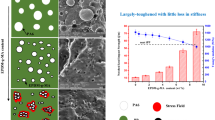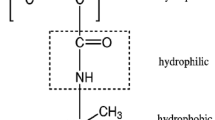Abstract
Effects of the addition of single but geometrically different cellulose nanocrystals (CNCs) namely cylindrical CNCs (ultrasonic treated), spherical CNCs (chemically treated) and rod-like CNCs (commercial) on microstructural development and mechanical performance of the thermoplastic vulcanizates (TPVs) based on polylactic acid/polyurethane prepolymer (80/20) were studied. It was shown that a fraction of PLA molecules reacted with PU molecules during the dynamic crosslinking process. This was confirmed by the results of gel content measurements which showed an appreciable amount of additional gel content. This phenomenon together with the dynamic vulcanization process facilitated the development of a dual-continuous morphology in the TPV sample which was confirmed by the melt viscoelastic results and TEM micrographs. Interestingly, the addition of spherical CNCs to the TPV led to a remarkable enhancement in its toughness. A similar effect but to a lesser extent was observed in the TPV sample filled with cylindrical CNCs. These results could be explained in terms of a 3D percolated or interconnected network microstructure formed between finely dispersed CNCs localized in PLA and/or between CNCs and the PLA matrix. This fact was evidenced by observation of strong liquid–solid transition in the melt viscoelastic results, as well as TEM and AFM micrographs. On contrary to other counterparts, the rod-like CNCs had a weakening effect on toughness of the TPV which was attributed to their poor dispersion and/or formation of their aggregates which could act as stress concentrators. Moreover, DMTA results showed an almost similar reinforcing effect for the three CNCs on increasing the modulus of the TPV below Tg of the PU and partially compensated the PU reducing effect on modulus in the temperature range between the Tg of PU and PLA.
Graphic abstract











Similar content being viewed by others
References
Auras R, Harte B, Selke S (2004) An overview of polylactides as packaging materials. Macromol Biosci 4:835–864
Bai H, Bai D, Xiu H, Liu H, Zhang Q, Wang K, Deng H, Chen F, Fu Q, Chiu FC (2014) Towards high-performance poly(L-lactide)/elastomer blends with tunable interfacial adhesion and matrix crystallization via constructing stereocomplex crystallites at the interface. RSC Adv 4:49374–49385. https://doi.org/10.1039/C4RA08823A
Bedő D, Imre B, Domján A, Schön P, Vancso GJ, Pukánszky B (2017) Coupling of poly(lactic acid) with a polyurethane elastomer by reactive processing. Eur Polym J 97:409–417. https://doi.org/10.1016/j.eurpolymj.2017.10.031
Bitinis N, Verdejo R, Bras J, Fortunati E, Kenny JM, Torre L, Lopez-Manchado MA (2013a) Poly(lactic acid)/natural rubber/cellulose nanocrystal bionanocomposites Part I. Processing and morphology. Carbohydr Polym 96:611–620. https://doi.org/10.1016/j.carbpol.2013.02.068
Bitinis N, Fortunati E, Verdejo R, Bras J, Kenny JM, Torre L, Manchado MA (2013b) Poly(lactic acid)/natural rubber/cellulose nanocrystal bionanocomposites. Part II: properties evaluation. Carbohydr Polym 96:621–627. https://doi.org/10.1016/j.carbpol.2013.03.091
Castillo JA, Borchmann DE, Cheng AY, Wang Y, Hu C, Garcia AJ, Weck M (2012) Well-defined poly(lactic acid)s containing poly(ethylene glycol) side-chains. Macromolecules 45:62–69. https://doi.org/10.1021/ma2016387
Chang K, Robertson ML, Hillmyer MA (2009) Phase inversion in polylactide/soybean oil blends compatibilized by poly (isoprene-b-lactide) block copolymers. ACS Appl Mater Interfaces 1:2390–2399. https://doi.org/10.1021/am900514v
Chatterjee K, Naskar K (2008) Study on characterization and properties of nanosilica-filled thermoplastic vulcanizates. Polym Eng Sci 48:1077–1084. https://doi.org/10.1002/pen.21052
Chen Y, Yuan DS, Xu CH (2014) Dynamically vulcanized biobased polylactide/natural rubber blend material with continuous cross-linked rubber phase. ACS Appl Mater Interfaces 6:381–3816. https://doi.org/10.1021/am5004766
Chen Y, Chen K, Wang Y, Xu Ch (2015) Biobased heat-triggered shape-memory polymers based on polylactide/epoxidized natural rubber blend system fabricated via peroxide-induced dynamic vulcanization: co-continuous phase structure, shape memory behavior, and interfacial compatibilization. Ind Eng Chem Res 54:8723–8731. https://doi.org/10.1021/acs.iecr.5b02195
Cheng Y, Deng S, Chen P, Ruan R (2009) Polylactic acid (PLA) synthesis and modifications: a review. Front Chem China 4:259–264. https://doi.org/10.1007/s11458-009-0092-x
Dogan SK, Reyes EA, Rastogi S, Ozkoc G (2014) Reactive compatibilization of PLA/TPU blends with a diisocyanate. J Appl Polym Sci 131:40251–40261. https://doi.org/10.1002/app.40251
Domingues RMA, Gomes ME, Reis RL (2014) The potential of cellulose nanocrystals in tissue engineering strategies. Biomacromolecules 15:2327–2346. https://doi.org/10.1021/bm500524s
Drumright RE, Gruber PR, Henton DE (2000) Polylactic acid technology. Adv Mater 12:1841–1846. https://doi.org/10.1002/1521-4095(200012)12:23%3c1841:AID-ADMA1841%3e3.0.CO;2-E
Fang H, Jiang F, Wu Q, Ding Y, Wang Z ( 2014) Supertough polylactide materials prepared through in situ reactive blending with PEG-based diacrylate monomer. ACS Appl Mater Inter 6:13552−13563. https://doi.org/10.1021/am502735q
Farah S, Anderson G, Langer D (2016) Physical and mechanical properties of PLA, and their functions in widespread applications—a comprehensive review. Adv Drug Deliv Rev 107:367–392. https://doi.org/10.1016/j.addr.2016.06.012
Ferreira FV, Pinheiro IF, Gouveia RF, Thim GP, Lona LMF (2018) Functionalized cellulose nanocrystals as reinforcement in biodegradable polymer nanocomposites. Polym Compos 39:9–29. https://doi.org/10.1002/pc.24583
Fortunati E, Peltzer M, Armentano I, Torre L, Jimenez A, Kenny JM (2012) Effects of modified cellulose nanocrystals on the barrier and migration properties of PLA nano-biocomposites. Carbohydr Polym 90:948–956. https://doi.org/10.1016/j.carbpol.2012.06.025
Goharpey F, Katbab A, Nazockdast H (2001) Mechanism of morphology development in dynamically cured EPDM/PP TPEs: I. Effects of state of cure. J Appl Polym Sci 81:2531–2544. https://doi.org/10.1002/app.1694
Goharpey F, Katbab A, Nazockdast H (2003) Formation of rubber particle agglomerates during morphology development in dynamically crosslinked EPDM/PP thermoplastic elastomers. Part 1: effects of processing and polymer structural parameters. Rubber Chem Technol 76:239–252. https://doi.org/10.5254/1.3547737
Grellmann W, Seidler S (2001) Deformation and fracture behavior of polymers. Springer, Berlin. https://doi.org/10.1007/978-3-662-04556-5
He YS, Zeng JB, Liu GC, Li QT, Wang YZ (2014) Supertough poly (l-lactide)/crosslinked polyurethane blends with tunable impact toughness. RSC Adv 4:12857–12866. https://doi.org/10.1039/C4RA00718B
Jamshidian M, Tehrany EA, Imran M, Jacquot M, Desobry S (2010) Poly-lactic acid: production, applications, nanocomposites, and release studies. Compr Rev Food Sci Food Saf 9:552–571. https://doi.org/10.1111/j.1541-4337.2010.00126.x
Jonoobi M, Harun J, Mathew AP, Oksman K (2010) Mechanical properties of cellulose nanofiber (CNF) reinforced polylactic acid (PLA) prepared by twin screw extrusion. Compos Sci Technol 70:1742–1747. https://doi.org/10.1016/j.compscitech.2010.07.005
Krishnan S, Pandey P, Mohanty S, Nayak SK (2015) Toughening of polylactic acid: an overview of research progress. Polym Plast Technol Eng. https://doi.org/10.1080/03602559.2015.1098698
Lee I, Panthani TR, Bates FS (2013) Sustainable poly (lactide-b-butadiene) multiblock copolymers with enhanced mechanical properties. Macromolecules 46:7387–7398. https://doi.org/10.1021/ma401508b
Liu H, Zhang J (2011) Research progress in toughening modification of poly(lactic acid). J Polym Sci Part B Polym Phys 49:1051–1083
Liu H, Chen F, Liu B, Estep G, Zhang J (2010) Super toughened poly(lactic acid) ternary blends by simultaneous dynamic vulcanization and interfacial compatibilization. Macromolecules 43:6058–6066. https://doi.org/10.1021/ma101108g
Liu GC, He YS, Zeng JB, Li QT, Wang YZ (2014a) Fully biobased and supertough polylactide-based thermoplastic vulcanizates fabricated by peroxide-induced dynamic vulcanization and interfacial compatibilization. Biomacromolecules 15:4260–4271. https://doi.org/10.1021/bm5012739
Liu GC, He YS, Zeng JB, Xu Y, Wang YZ (2014b) In situ formed crosslinked polyurethane toughened polylactide. Polym Chem 5:2530–2539. https://doi.org/10.1039/C3PY01649H
Liu L, Hou J, Wang L, Zhang J, Duan Y (2016) Role of dicumyl peroxide on toughening PLLA via dynamic vulcanization. Ind Eng Chem Res 55:9907–9914. https://doi.org/10.1021/acs.iecr.6b02122
Liu Y, Cao L, Yuan D, Chen Y (2018) Design of super-tough co-continuous PLA/NR/SiO2 TPVs with balanced stiffness-toughness based on reinforced rubber and interfacial compatibilization. Compos Sci Technol 165:231–239. https://doi.org/10.1016/j.compscitech.2018.07.005
Lu X, Wei X, Huang J, Yang L, Zhang G, He G, Wang M, Qu J (2014) Supertoughened poly(lactic acid)/polyurethane blend material by in situ reactive interfacial compatibilization via dynamic vulcanization. Ind Eng Chem Res 53:17386–17393. https://doi.org/10.1021/ie503092w
Ma P, Xu P, Zhai Y, Dong W, Zhang Y, Chen Y (2015a) Biobased poly(lactide)/ethylene-co-vinyl acetate thermoplastic vulcanizates: morphology evolution, superior properties, and partial degradability. ACS Sustain Chem Eng 3:2211–2219. https://doi.org/10.1021/acssuschemeng.5b00462
Ma P, Xu P, Liu W, Zhai Y, Dong W, Zhang Y, Chen M (2015b) Bio-based poly (lactide)/ethylene-co-vinyl acetate thermoplastic vulcanizates by dynamic crosslinking: structure vs. property. RSC Adv 5:15962–15968. https://doi.org/10.1039/C4RA14194F
Mani S, Cassagnau P, Bousmina M, Chaumont P (2011) Morphology development in novel composition of thermoplastic vulcanizates based on PA12/PDMS reactive blends. Macromol Mater Eng 296:909–920. https://doi.org/10.1002/mame.201000406
Mirzadeh A, Lafleur PG, Kamal MR, Dubois C (2013) Morphology evolution and thermomechanical characteristics of tpv nanocomposites based on PP/EPDM prepared by reactive extrusion. Rubber Chem Technol 86:521–537. https://doi.org/10.5254/RCT.13.87996
Ning N, Li S, Wu H, Tian H, Yao P, Hu GH, Tian M, Zhang L (2018) Preparation, microstructure, and microstructure-properties relationship of thermoplastic vulcanizates (TPVs): a review. Prog Polym Sci 79:61–97. https://doi.org/10.1016/j.progpolymsci.2017.11.003
Odent J, Habibi Y, Raquez JM, Dubois P (2013) Ultra-tough polylactide-based materials synergistically designed in the presence of rubbery ε-caprolactone-based copolyester and silica nanoparticles. Compos Sci Technol 84:86–91. https://doi.org/10.1016/j.compscitech.2013.05.003
Randall D, Lee S (2003) The polyurethanes book. Wiley, New York
Rasal RM, Janorkar AV, Hirt DE (2010) Poly(lactic acid) modifications. Prog Polym Sci 35:338–356
Roy M, Van Duin M, Spoelstra AB, Goossens JG (2010) The rubber particle size to control the properties-processing balance of thermoplastic/cross-linked elastomer blends. Soft Matter 6:1758–1768. https://doi.org/10.1039/B913458A
Sethi J, Illikainen M, Sain M, Oksman K (2017) Polylactic acid/polyurethane blend reinforced with cellulose nanocrystals with semi-interpenetrating polymer network (S-IPN) structure. Eur Polym J 86:188–199. https://doi.org/10.1016/j.eurpolymj.2016.11.031
Shakouri Z, Nazockdast H (2018) Microstructural development and mechanical performance of PLA/TPU blends containing geometrically different cellulose nanocrystals. Cellulose 25:7167–7188. https://doi.org/10.1007/s10570-018-2061-3
Tzetzis D, Mansour G (2016) Nanoindentation, compression and fractural characterization of highly dispersed epoxy silica nanocomposites. J Reinf Plast Compos 35:541–555. https://doi.org/10.1177/0731684415623653
Viet D, Beck-Candanedo S, Gray DG (2007) Dispersion of cellulose nanocrystals in polar organic solvents. Cellulose 14:109–113. https://doi.org/10.1007/s10570-006-9093-9
Vilay V, Todo M, Jaafar M, Ahmad Z, Pasomsouk K (2010) Characterization of microstructure and mechanical properties of biodegradable polymer blends of poly(l-lactic acid) and poly(butylene succinate-co-ε-caprolactone) with lysine triisocyanate. Polym Eng Sci 50:1485–1491. https://doi.org/10.1080/03602559.2013.763350
Wang LP, Hou JR, Duan YX, Zhang JM (2014) Influence of interfacial compatibelizers on the properties of nitrile butadiene rubber toughening poly (l-lactide) system. Acta Polym Sin 7:914–921. https://doi.org/10.11777/j.issn1000-3304.2014.13401
Wu H, Tian M, Zhang L, Tian H, Wu Y, Ning N, Hu GH (2016) Effect of rubber nanoparticle agglomeration on properties of thermoplastic vulcanizates during dynamic vulcanization. Polymers 8:127–139. https://doi.org/10.3390/polym8040127
Xia X, Liu W, Zhou L, Liu H, He S, Zhu C (2015) Study on flax fiber toughened poly(lactic acid) composites. J Appl Polym Sci 132:42573. https://doi.org/10.1002/app.42573
Xu P, Ma P, Cai X, Song S, Zhang Y, Dong W, Chen M (2016) Selectively cross-linked poly (lactide)/ethylene-glycidyl methacrylate-vinyl acetate thermoplastic elastomers with partial dual-continuous network-like structures and shape memory performances. Eur Polym J 84:1–12. https://doi.org/10.1016/j.eurpolymj.2016.09.004
Yao P, Wu H, Ning N, Zhang L, Tian H, Wu Y, Hu GH, Chan TW, Tian M (2016) Properties and unique morphological evolution of dynamically vulcanized bromo-isobutylene-isoprene rubber/polypropylene thermoplastic elastomer. RSC Adv 6:11151–11160. https://doi.org/10.1039/C5RA26171F
Yuan DS, Chen ZH, Xu CH, Chen KL, Chen YK (2015) Fully biobased shape memory material based on novel cocontinuous structure in poly (lactic acid)/natural rubber TPVs fabricated via peroxide-induced dynamic vulcanization and in situ interfacial compatibilization. ACS Sustain Chem Eng 3:2856–2865. https://doi.org/10.1021/acssuschemeng.5b00788
Zdrahala RJ, Zdrahala IJ (1999) Biomedical applications of polyurethanes: a review of past promises, present realities, and a vibrant future. J Biomater Appl 14:67–90. https://doi.org/10.1177/088532829901400104
Zhang N, Lu X (2016) Morphology and properties of super-toughened bio-based poly (lactic acid)/poly (ethylene-co-vinyl acetate) blends by peroxide-induced dynamic vulcanization and interfacial compatibilization. Polym Test 56:354–363. https://doi.org/10.1016/j.polymertesting.2016.11.003
Zhao X, Yu X, Chen H, Zhou W, Fang P, Peng S (2018) Interfacial compatibility of super-tough poly(lactic acid)/polyurethane blends investigated by positron annihilation lifetime spectroscopy. J Appl Polym Sci 135:46596–46602. https://doi.org/10.1002/APP.46596
Acknowledgments
The authors acknowledge the financial support provided by the Iranian National Nanotechnology network. The authors are also grateful to FP Innovations for providing the rod-like CNCs and also Pars polyurethane company for offering the PU prepolymer.
Author information
Authors and Affiliations
Corresponding author
Additional information
Publisher's Note
Springer Nature remains neutral with regard to jurisdictional claims in published maps and institutional affiliations.
Rights and permissions
About this article
Cite this article
Shakouri, Z., Nazockdast, H. & Sadeghi Ghari, H. Effect of the geometry of cellulose nanocrystals on morphology and mechanical performance of dynamically vulcanized PLA/PU blend. Cellulose 27, 215–231 (2020). https://doi.org/10.1007/s10570-019-02775-5
Received:
Accepted:
Published:
Issue Date:
DOI: https://doi.org/10.1007/s10570-019-02775-5




